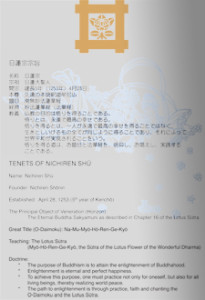On October 8th 1282 CE, shortly before his death, Nichiren Shōnin appointed six senior disciples, or the Roku Roso (六老僧), that would go on to each form their own lineage. Nichiren Shū (日蓮宗, which literally means “Nichiren Sect”) is a confederation of these schools. Nisshō (日昭) founded the Hama school and its head temple Myōhokke-ji. Nichirō (日朗) founded the Ikegami school, centered at the Ikegami Honmon-ji and Myohon-ji temples. Nikkō (日興) founded the Fuji school, part of which would break away from Nichiren Shū in 1900 CE along with the Fuji school’s head temple Taiseki-ji. Nikō (日向) took over Minobusan Kuon-ji after Nichiren’s death and is considered the founder of the Minobu school. Nitchō (日頂) was appointed a senior disciple, but it was his stepfather Nichijo (Toki Jonin) who founded the Nakayama lineage centered at the temples Mama Guho-ji, Wakamiya Hokke-ji and Nakayama Hommyo-ji — the latter two of which would later join to form the temple Nakayama Hokekyo-ji. Nichiji (日持) left Japan after Nichiren’s death, intending to spread the Wonderful Dharma through China on his way to ultimately reach the Mongol capital and convert their empire. For centuries his fate was a mystery, until his gohonzon and writings were found in the Xuanhuan District of China in 1936 CE. It is now known that there he founded the Lìhuà Temple, gained a number of Chinese followers of Nichiren Buddhism, and even appointed his own chief disciple from China. Though Nichiji has no existing lineage today he is considered by Nichiren Shū to be the great Renge-Ajari, the patron saint of overseas missionaries. For this reason he is incredibly important to American temples, and is included in the prayers of our daily services. For several centuries the lineages existed independently of one another, and each temple more or less operated autonomously. But when the Meiji Emperor was restored in 1868 CE the Japanese government began a campaign to consolidate the disparate Buddhist orders, largely shaping the Japanese sects we see today. It was during this climate of consolidation that, in 1876, the lineages described above joined, becoming the Nichiren Shū. Though we confederated in 1876, the lineages within our order all share the same founding date of April 8th, 1253 CE at Seicho-ji.
The Crest

The Tachibana Crest
Our Order
Our Head Temple
Our head temple is Minobusan Kuon-ji (身延山久遠寺), founded in 1281 CE by Nichiren Shōnin seven years after his retirement to Mount Minobu. Here he wrote two of his Five Major Writings, the Senji Shō (撰時抄) and the Hōon Shō (報恩抄). Nichiren’s ashes are entombed here, in accordance with his final wishes. Minobusan Kuon-ji is located at Minobu 3567, Minobu, Minamikoma-gun, Yamanashi Pref. Japan.
Our Administrative Headquarters
Our Administrative Headquarters are located at Ikegami Honmon-ji (池上本門寺), where Nichiren Shōnin passed away on October 13th 1282 CE at what was then the home of lay follower Ikegami Munenaka. This is where Nichiren appointed his six senior disciples. Ikegami Honmon-ji is located at 1-32-15 Ikegami, Ota-ku, 146-8544 Tokyo.
Our Archbishop
Rev. Nissho Uchino, Chief Abbot of Minobusan Kuon-ji, is the 52nd Archbishop of Nichiren Shū. He was installed as our Archbishop on May 10th 2010. He succeeded Nichiji Sakai, the head minister of Ikegami Honmon-ji.
Nichiren Shū online
- Nichiren Shū official website: http://www.nichiren.or.jp/
- Nichiren Shū official English-language website: http://www.nichiren.or.jp/english/
- Nichiren Buddhist International Center website: http://www.nichiren-shu.org/
- Nichiren Shū Yahoo Group: http://groups.yahoo.com/neo/groups/nichirenshubuddhism/info

